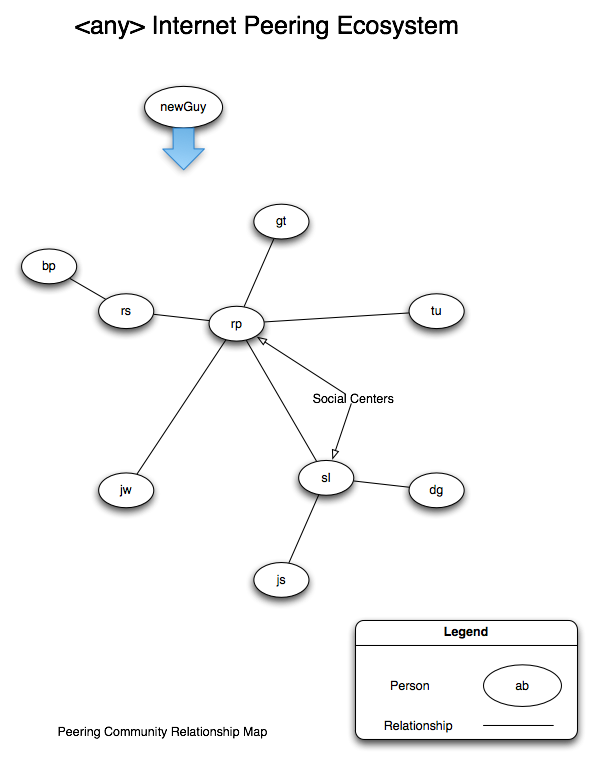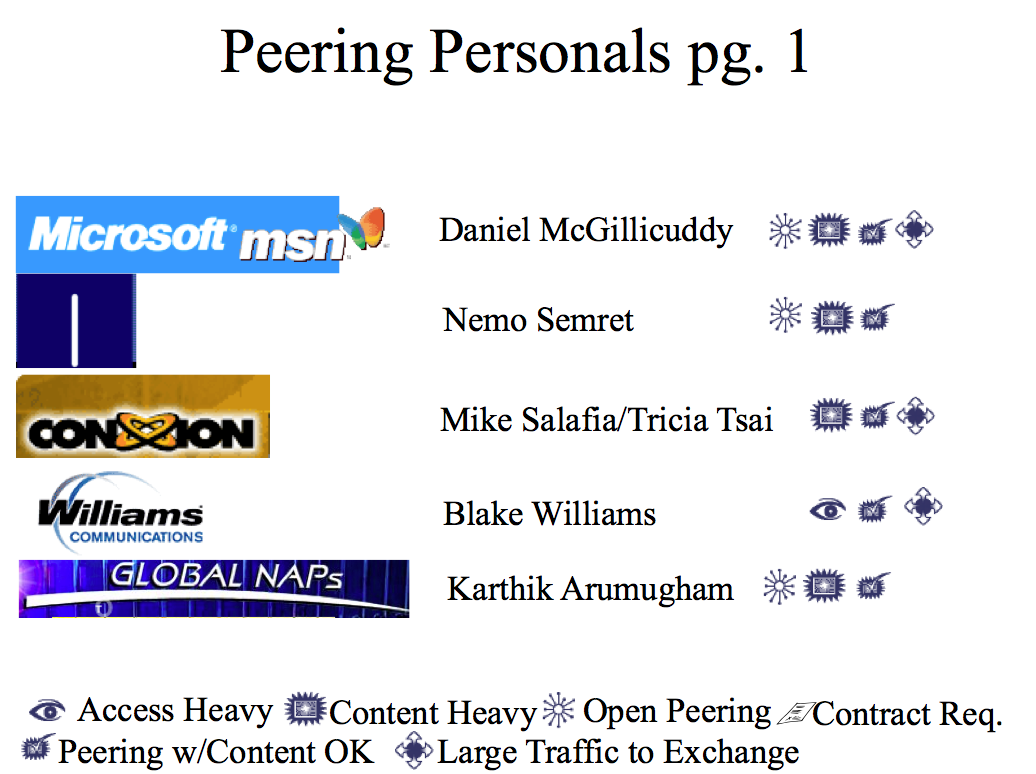How do peering people meet each other? It may seem cliquey and a difficult community to get into, but there are a variety of methods that ease entry.
This brief prescribes methods for getting into the Peering Coordinator community. We also describe in brief the social backbone of the Peering Coordinator community. And finally we share the Peering Personals process that was initiated at the Equinix Gigabit Peering Forums started back in 2001 and adopted and refined at many Internet Peering Fora today.
last updated August 2010
One question comes up very often but rarely in this direct form:
"How do I get into the Peering community?"
It tends to take three sequential meetings to be seen as a regular at any smallish (<500 attendee) Internet conference. The first time, you know no one, and no one knows you, and maybe you meet a couple people. You may notice a couple people who seem to know everyone. The second time, you see the people who seem to know everyone again and maybe a person or two you met at the first one. The third one, maybe you meet one of those people who seem to know everyone, and maybe they recognize you from the previous meetings. It is face recognition and company affiliation thing, at least this is what people seem to key on, as in "Oh, this is Reg from the engineering group at NG Telekom."
Companies that send different people to each peering fora, usually out of an internal sense of fairness, do themselves a disservice since no one on their staff is ever recognized as a regular attendee.
"Is the Peering Community Cliquey?"
From Merriam-Webster - The Free Dictionary:
cli·quey /ˈklēkē/ Adjective
1. (of a group or place) Tending to form or hold exclusive groups.
2. (of music or art) Appealing only to a small group or minority.
It is not as exclusive as it may appear from the outside. I would guess that maybe 60% of the attendees already know others at a peering forum. The regular attendees with the larger social networks seem to have little catchup reunions when they first see each other at the meetings, so it may seem like you are attending a strangers party. But there are some very cool people that like to help.
There are about five people I would refer to as "Social Centers" in the Peering Coordinator Community who do seem to know everyone as shown in the simplified diagram below.

(A more realistic map would be much more meshy, indicative of the fact that so many of the peering coordinators know each other, but if we were to look at the strong relationships, and also the sheer number of relationships maintained, we would see a handful of clearly identifiable social centers.)
These folks are also very nice about doing introductions to peering people that you want to meet. It is important that you have your top 50 target AS list handy and know who is attending the event from these target organizations. It is also helpful to have some background information on your targets, like their peering inclinations, who they already peer with that is like your company, etc.
And don't go after the largest or the most selective or restrictive targets first. You might think that this would make you appear to be a more attractive peering candidate or an important player, but it will most likely come off as ignorance. Everyone that is familiar with the industry sector knows that no amount of cozying up to Sprint (for example) will result in peering, and that Sprint knows who their peering candidates are already. Bringing them up first will backfire; the larger peering targets, if it is possible to per with them, will require some skill and strategy. You do not want a newbie to pursue this.
When we researched the peering process we identified the ways that seasoned peering coordinators identify who they needed to speak with about peering (see the "Top 10 ways seasoned Peering Coordinators Contact Target ISPs" section below).
Many peering fora have adopted the Peering Personals that Ted Hardie and I started back at the Equinix Gigabit Peering Forums in 2004. We evolved it a bit with icons, a bit of social engineering, and even a Windows-based program to execute it, but fundamentally Peering Personals has remained the same - a broadcast method for peering people to meet each other at a peering forum. After all, that is one of the big reasons that they attended the peering forum in the first place.
We put the peer's important information on the screen behind the peering coordinator. Specifically, the screen highlights the peer's ASN, company name, amount of traffic they exchanged in total, what they looked for in a peer and why people in the audience should want to peer with them, contact information, etc. This way, while they speak, the audience can jot down the information, and not have to count on hearing the speaker say the words. People sometimes get nervous and speed through this information. Sometimes there is a language issue. Sometimes people forget to say important things. The MC has a role here to make sure that the interesting, relevant, important information is communicated to the group.


A Current Peering Personals Format, and A Icon-based Peering Personals from NANOG 25 in June 2002
Frank Orlowski and the DE-CIX team put on a top-rate peering forum in September 2010 in Frankfurt that included a Peering Personals section. The dynamic was wonderful - it illustrated how many countries were in attendance, the many differing opinions in the group, and the wide variety of routes available for peering.
The MC role in the Peering Personals event is important. This person facilitates the audience discussion. If the MC role is done correctly, the Peering Personals feels like a dialogue between the audience members and the peers and helps speed the peering discussions that follow.
This Peering Personals method has proven to be an effective method up to about 20 peering personals; after 15-20 peering personals people seemed to forget what the first person said and what they looked like.
WIlliam B. Norton is the author of The Internet Peering Playbook: Connecting to the Core of the Internet, a highly sought after public speaker, and an international recognized expert on Internet Peering. He is currently employed as the Chief Strategy Officer and VP of Business Development for IIX, a peering solutions provider. He also maintains his position as Executive Director for DrPeering.net, a leading Internet Peering portal. With over twenty years of experience in the Internet operations arena, Mr. Norton focuses his attention on sharing his knowledge with the broader community in the form of presentations, Internet white papers, and most recently, in book form.
From 1998-2008, Mr. Norton’s title was Co-Founder and Chief Technical Liaison for Equinix, a global Internet data center and colocation provider. From startup to IPO and until 2008 when the market cap for Equinix was $3.6B, Mr. Norton spent 90% of his time working closely with the peering coordinator community. As an established thought leader, his focus was on building a critical mass of carriers, ISPs and content providers. At the same time, he documented the core values that Internet Peering provides, specifically, the Peering Break-Even Point and Estimating the Value of an Internet Exchange.
To this end, he created the white paper process, identifying interesting and important Internet Peering operations topics, and documenting what he learned from the peering community. He published and presented his research white papers in over 100 international operations and research forums. These activities helped establish the relationships necessary to attract the set of Tier 1 ISPs, Tier 2 ISPs, Cable Companies, and Content Providers necessary for a healthy Internet Exchange Point ecosystem.
Mr. Norton developed the first business plan for the North American Network Operator's Group (NANOG), the Operations forum for the North American Internet. He was chair of NANOG from May 1995 to June 1998 and was elected to the first NANOG Steering Committee post-NANOG revolution.
William B. Norton received his Computer Science degree from State University of New York Potsdam in 1986 and his MBA from the Michigan Business School in 1998.
Read his monthly newsletter: http://Ask.DrPeering.net or e-mail: wbn (at) TheCoreOfTheInter (dot) net
Click here for Industry Leadership and a reference list of public speaking engagements and here for a complete list of authored documents
The Peering White Papers are based on conversations with hundreds of Peering Coordinators and have gone through a validation process involving walking through the papers with hundreds of Peering Coordinators in public and private sessions.
While the price points cited in these papers are volatile and therefore out-of-date almost immediately, the definitions, the concepts and the logic remains valid.
If you have questions or comments, or would like a walk through any of the paper, please feel free to send email to consultants at DrPeering dot net
Please provide us with feedback on this white paper. Did you find it helpful? Were there errors or suggestions? Please tell us what you think using the form below.
Contact us by calling +1.650-614-5135 or sending e-mail to info (at) DrPeering.net